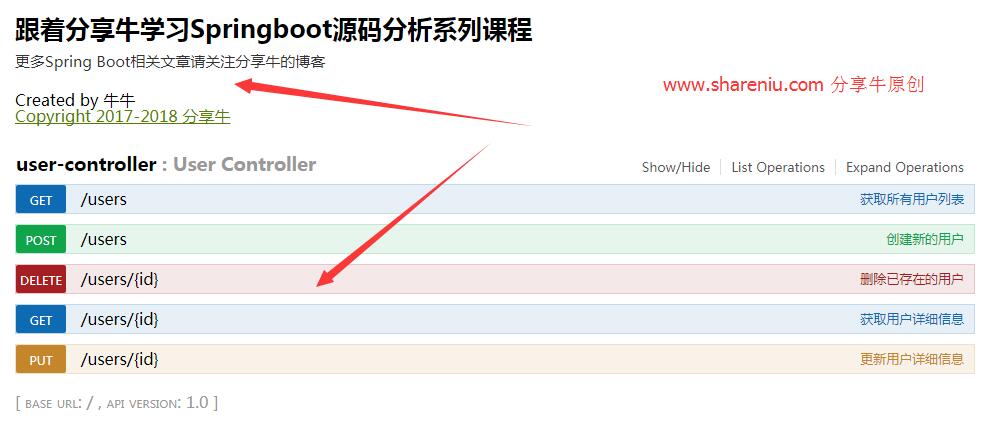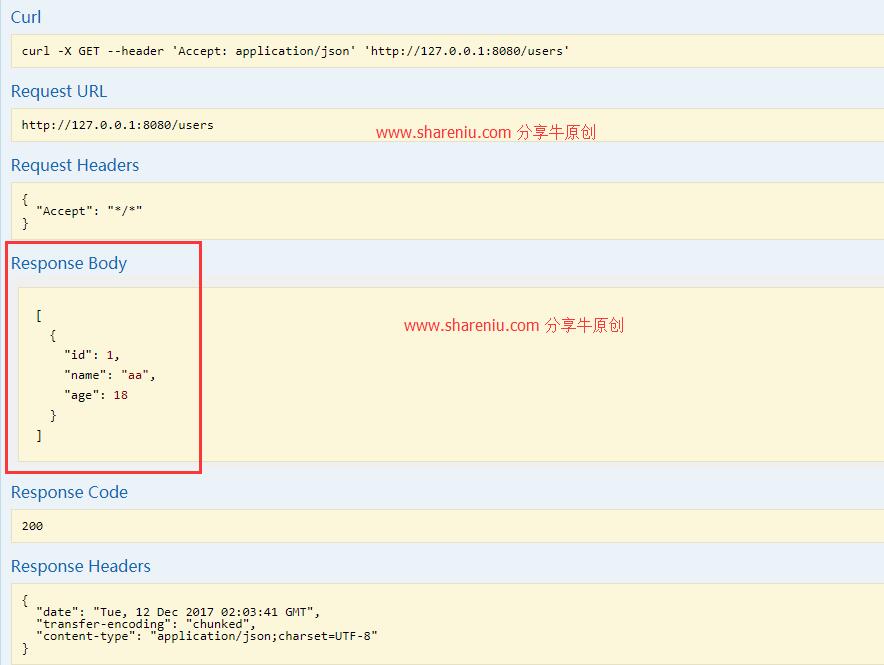Springboot集成Swagger2
摘要:在项目开发中,往往期望做到前后端分离,也就是后端开发人员往往需要输出大量的服务接口,接口的提供方无论是是 Java还是PHP等语言,往往会要花费一定的精力去写接口文档,比如A接口的地址、需要传递参数情况、返回值的JSON数据格式以及每一个字段说明、当然还要考虑HTTP请求头、请求内容等信息。随着项目的进度快速高速的迭代,后端输出的接口往往会面临修改、修复等问题,那也意味着接口文档也要进行相应的调整。接口文档的维护度以及可读性就大大下降。既然接口文档需要花费精力去维护,还要适当的进行面对面交流沟通,我们何不想一个办法,第一:可以不用写接口文档;第二:前端与后端沟通接口问题的时候,后端是否可以提供一个URL,在这个URL中罗列出所有可以调用的服务接口,并在每个服务接口中罗列出参数的说明,返回值的说明,第三:后端接口如果能模拟调用就所有问题都解决了。本文我们重点讲解一下Sringboot中集成 Swagger2 框架。
1.1. 添加Swagger2依赖
在项目的 pom.xml文件中增加如下的依赖。
<dependency>
<groupId>io.springfox</groupId>
<artifactId>springfox-swagger2</artifactId>
<version>2.7.0</version>
</dependency>
<dependency>
<groupId>io.springfox</groupId>
<artifactId>springfox-swagger-ui</artifactId>
<version>2.7.0</version>
</dependency>
首先,我们需要建立一个启动类,代码如下:
@SpringBootApplication
public class Application {
public static void main(String[] args) {
SpringApplication.run(Application.class, args);
}
然后在上述类的同级目录中新建 swagger2的配置类如下所示:
@Configuration
@EnableSwagger2
public class Swagger2 {
@Bean
public Docket createRestApi() {
return new Docket(DocumentationType.SWAGGER_2)
.apiInfo(apiInfo())
.select()
.apis(RequestHandlerSelectors.basePackage("com.shareniu.web"))
.paths(PathSelectors.any())
.build();
}
private ApiInfo apiInfo() {
return new ApiInfoBuilder()
.title("跟着分享牛学习Springboot源码分析系列课程")
.description("更多Spring Boot相关文章请关注分享牛的博客")
.termsOfServiceUrl("http://www.shareniu.com/")
.contact("牛牛")
.license("Copyright 2017-2018 分享牛")
.version("1.0")
.build();
}
}
@Configuration制定了spring要加载这个类,@EnableSwagger2注解要开启Swagger功能。
上述中的 ApiInfo最终都会展现在前端,我们使用了扫描包的方式配置配置,也就是RequestHandlerSelectors.basePackage。在这个包以及子包中的控制器最终都是生成API文档。(除了被@ApiIgnore注解 指定的请求)。
1.2. 新增文档说明
上述的类声明之后,我们其实就可以直接调用了,但是为了增加文档的可读性,我们还是需要在接口中增加一些说明,我们先写一个控制器如下所示:
@RestController
@RequestMapping(value="/users")
public class UserController {
static Map<Long, User> users = Collections.synchronizedMap(new HashMap<Long, User>());
static {
User user = new User();
user.setAge(18);
user.setId(1L);
user.setName("aa");
users.put(1L, user);
}
@ApiOperation(value="获取所有用户列表", notes="")
@RequestMapping(value={""}, method=RequestMethod.GET)
public List<User> getUserList() {
List<User> r = new ArrayList<User>(users.values());
return r;
}
@ApiOperation(value="创建新的用户", notes="根据User对象创建用户")
@ApiImplicitParam(name = "user", value = "用户详细实体user", required = true, dataType = "User")
@RequestMapping(value="", method=RequestMethod.POST)
public String postUser(@RequestBody User user) {
users.put(user.getId(), user);
return "success";
}
@ApiOperation(value="获取用户详细信息", notes="根据url的id来获取用户详细信息")
@ApiImplicitParam(name = "id", value = "用户ID", required = true, dataType = "Long")
@RequestMapping(value="/{id}", method=RequestMethod.GET)
public User getUser(@PathVariable Long id) {
return users.get(id);
}
@ApiOperation(value="更新用户详细信息", notes="根据url的id来指定更新对象")
@ApiImplicitParams({
@ApiImplicitParam(name = "id", value = "用户ID", required = true, dataType = "Long"),
@ApiImplicitParam(name = "user", value = "用户详细实体user", required = true, dataType = "User")
})
@RequestMapping(value="/{id}", method=RequestMethod.PUT)
public String putUser(@PathVariable Long id, @RequestBody User user) {
User u = users.get(id);
u.setName(user.getName());
u.setAge(user.getAge());
users.put(id, u);
return "success";
}
@ApiOperation(value="删除已存在的用户", notes="根据url的id来指定删除对象")
@ApiImplicitParam(name = "id", value = "用户ID", required = true, dataType = "Long")
@RequestMapping(value="/{id}", method=RequestMethod.DELETE)
public String deleteUser(@PathVariable Long id) {
users.remove(id);
return "success";
}
}
@ApiOperation:用来描述该接口的作用。可以通过该注解说明接口的职责、返回头信息、方法的请求方式("GET", "HEAD", "POST", "PUT", "DELETE", "OPTIONS" and "PATCH")、协议( http, https, ws, wss )、 http状态码。
@ApiImplicitParam:用来给参数增加说明。可以设置参数的名称、是否是必填项、参数的描述信息、是否只读等。
上述代码提交之后,启动 springboot,访问http://127.0.0.1:8080/swagger-ui.html,如下图所示:

上图分为两个部分,上部分是通过 Swagger2类配置出来的,下半部分是UserController类中的接口文档。
这里我们以 /user为例进行说明:
点击 /user如下图所示:

上图黄色的地方表示,该接口返回的样例数据。也就是 User的数据结构。Response Content Type:接口返回的头信息。点击Try it out。如下所示:

该接口返回的 baody、code码、响应头已经成功返回了。
- 本文标签: 配置 Document 开发 java js IO SDN XML 删除 源码 map springboot HTML 参数 spring https bean API Collections http 协议 cat Spring Boot App REST 目录 Service ip 数据 json src PHP description id CTO list 文章 UI Select build web Collection 代码 value 博客 pom
- 版权声明: 本文为互联网转载文章,出处已在文章中说明(部分除外)。如果侵权,请联系本站长删除,谢谢。
- 本文海报: 生成海报一 生成海报二











![[HBLOG]公众号](https://www.liuhaihua.cn/img/qrcode_gzh.jpg)

